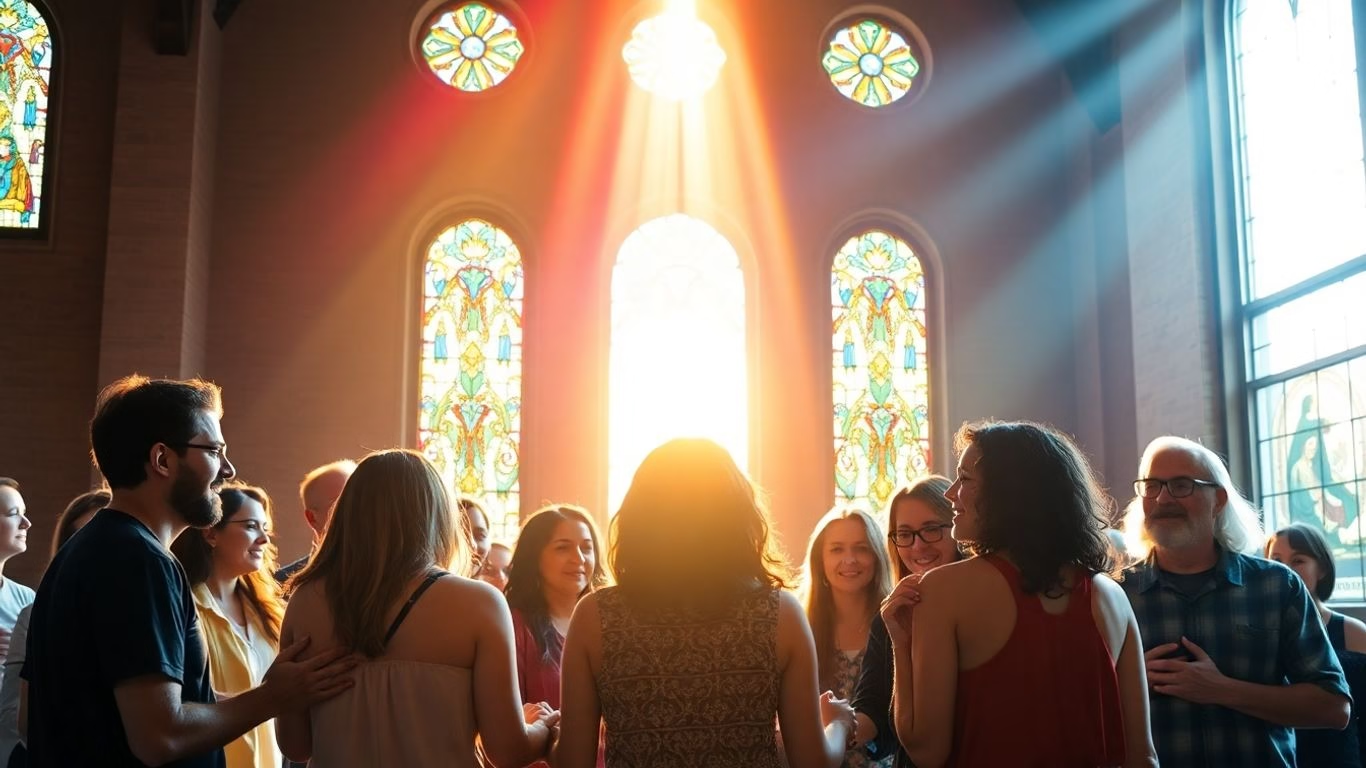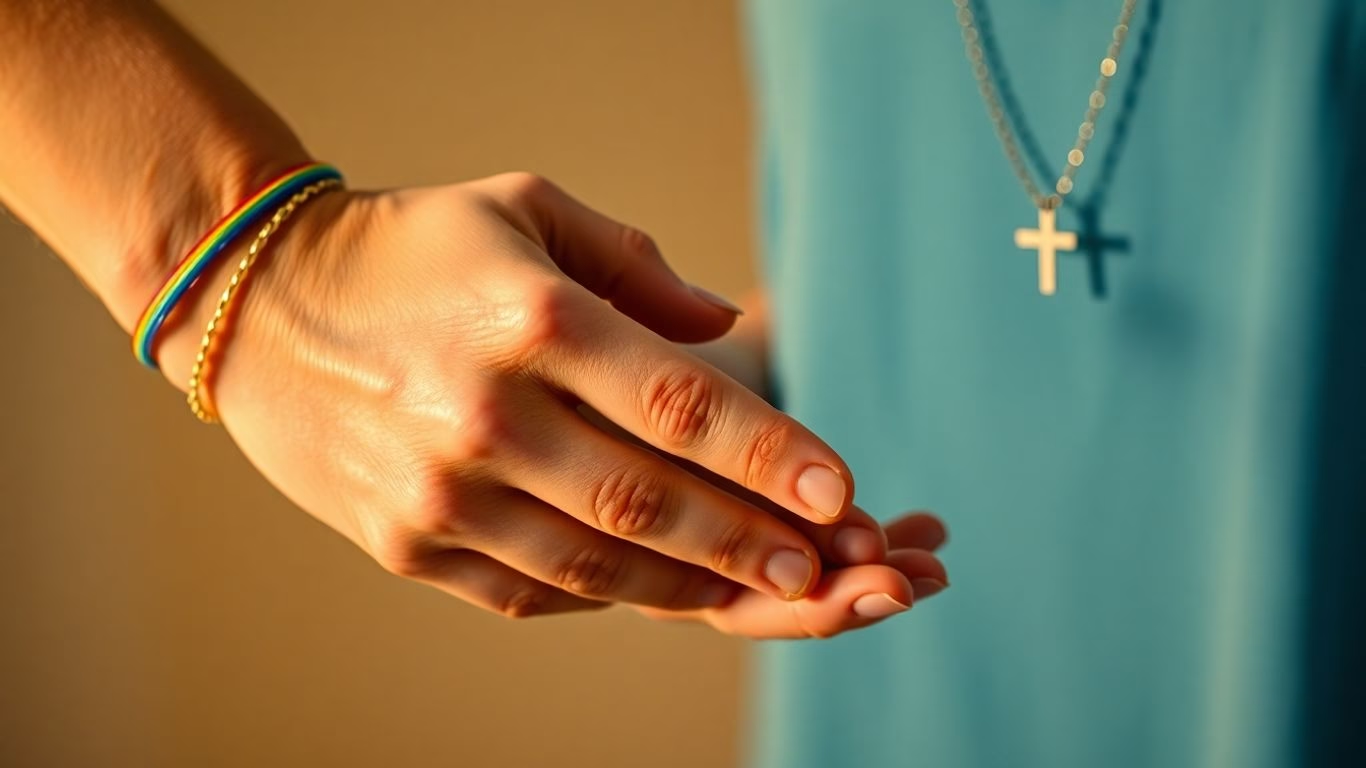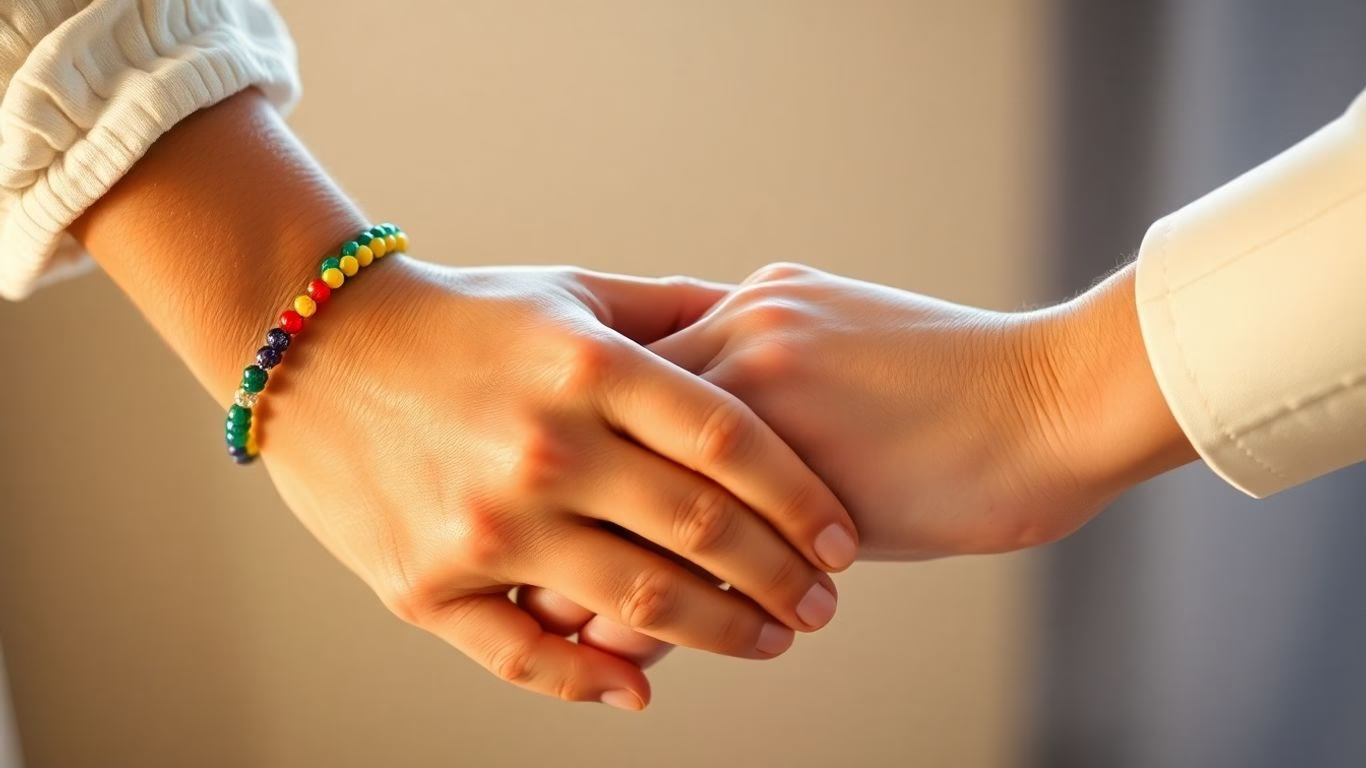It can feel like a big hurdle, trying to figure out how your faith and your LGBTQ+ identity fit together. For a long time, it seemed like you had to pick one or the other, which is tough when both are such important parts of who you are. But it doesn’t have to be that way. This article is about exploring how to bring these two big parts of yourself into a more peaceful place, showing that you can be both religious and a part of the LGBTQ+ community. We’ll look at some common ideas that make it seem impossible and then talk about ways to find that harmony.
Key Takeaways
- It’s a myth that being LGBTQ+ and having faith are automatically at odds; many people find ways to embrace both identities.
- Not every religious group is against LGBTQ+ people; many are actively inclusive and affirming.
- You can find personal peace by looking at your faith’s texts for messages of love and acceptance, and by accepting yourself.
- Finding supportive friends, family, and organizations can make a huge difference in feeling less alone.
- Faith can actually be a source of strength and help in dealing with stress, contributing to overall well-being.
Challenging Myths About Faith and LGBTQ+ Identity

It’s a common idea out there that you can’t be both religious and LGBTQ+. This often comes from a place of misunderstanding or maybe just not seeing the full picture. But honestly, that’s just not the case for so many people. Let’s break down some of these common myths that make it seem like these two parts of ourselves just don’t fit together.
Religion and LGBTQ+ Identities Are Not Incompatible
One of the biggest myths is that being LGBTQ+ and having faith are totally at odds. This usually pops up because some religious teachings have historically been pretty harsh on queer folks. But here’s the thing: lots of LGBTQ+ people find real spiritual comfort and meaning within their faith communities. It’s not as rare as you might think; a good chunk of LGBTQ+ adults actually report having a religious affiliation. This shows that many are finding ways to connect their identity with their beliefs, often in non-Christian faiths too, which just goes to show how diverse spiritual paths can be.
Not All Religious Communities Oppose LGBTQ+ Rights
Another myth is that every single religious group is against LGBTQ+ rights. If you’ve ever seen the vibrant faith contingents at pride events, you know that’s not true. While some denominations stick to more traditional views, many others are actively welcoming and supportive of LGBTQ+ people. You’ll find denominations like the Presbyterian Church (U.S.A.), Reform Judaism, and the Unitarian Universalist Association have publicly stated their support for same-sex marriage. Even in places that have been more conservative, there are often groups and individuals pushing for change and greater acceptance.
Supporting LGBTQ+ Inclusion Does Not Mean Opposing Religious Beliefs
Sometimes people think that if you support LGBTQ+ inclusion, you must be against religious beliefs. This creates a false choice. You can absolutely support LGBTQ+ people and also respect religious freedom. Many workplaces and communities are figuring out how to be inclusive without asking people to ditch their personal beliefs. It’s more about making sure everyone is treated with respect, no matter their identity or faith.
Religious Beliefs Can Evolve Over Time
The idea that religious doctrines are set in stone and never change is also a myth. Religions, like cultures, evolve. Interpretations of scripture and tradition can shift over time, especially as we learn more and as society changes. This evolution allows for more inclusive understandings to emerge, making space for LGBTQ+ individuals within faith traditions. It’s a slow process sometimes, but change does happen.
The journey of reconciling faith and LGBTQ+ identity is deeply personal. It’s about challenging assumptions and finding spaces where all parts of yourself are not only accepted but celebrated. The narrative that these two aspects of life are mutually exclusive is a harmful myth that doesn’t reflect the lived experiences of countless individuals.
- Many LGBTQ+ individuals find that their faith provides a strong foundation for coping with the stress that can come with being part of a minority group. Practices like prayer, studying religious texts, and connecting with supportive congregations can be incredibly helpful. These spiritual anchors can aid in navigating life’s challenges, from family issues to relationships. This research even points to a positive link between religiousness, spirituality, and the well-being of queer people.
- Historically, some religious interpretations have been used to condemn LGBTQ+ identities. However, this is not a universal stance across all faiths or even within denominations.
- The concept of a single, unchangeable “gay gene” has been disproven by scientific studies, particularly those involving identical twins. This highlights that sexual orientation is complex and not determined by a single genetic factor.
Finding Harmony Between Faith and LGBTQ+ Identity
It can feel like a huge hurdle, trying to make your faith and your LGBTQ+ identity fit together. For so long, it felt like an either/or situation, right? Like you had to pick one or the other. But honestly, that’s just not the case for so many people. You don’t have to choose between who you love and what you believe. It’s about finding a way for these parts of yourself to coexist, and even to strengthen each other.
Recognize Queerness and Faith Can Be Complementary
Sometimes, the idea of full integration feels too big to tackle all at once. That’s okay. Start small. Think about how themes of love and acceptance in your faith tradition might apply to your own life and identity. Many find that focusing on these core messages can help bridge the gap. It’s about personal interpretation and finding meaning that speaks to you. You might discover that your faith actually encourages you to explore and understand yourself more deeply, including your queer identity.
Reread Your Religion’s Scripture for Inclusive Meanings
This is where things can get really interesting. Instead of taking religious texts at face value, especially interpretations that have historically excluded LGBTQ+ people, try looking at them with fresh eyes. What if you searched for passages about love, justice, or belonging? Many scholars and individuals have found new meanings in scripture that affirm LGBTQ+ lives. It’s about engaging with the text in a way that honors your whole self. You might be surprised by what you find when you look for inclusivity.
Embrace Self-Acceptance and Compassion
This journey is deeply personal. It requires a lot of introspection and kindness towards yourself. Acknowledge that you are whole, exactly as you are. Your faith and your LGBTQ+ identity are not in conflict; they are both valid and important parts of your story. Allow yourself the grace to explore this intersection without judgment. It’s a process, and it’s okay if it takes time. Finding resources and communities that affirm both aspects of your identity can make a world of difference. You can find helpful bibliographies of books discussing LGBTQIA+ religion and spirituality to start your research here.
Here are a few steps to consider:
- Reflect on Core Values: What aspects of your faith are most important to you? How do these values align with your understanding of yourself and your relationships?
- Seek Affirming Interpretations: Look for religious leaders, theologians, or communities that offer interpretations of scripture and tradition that are inclusive of LGBTQ+ people.
- Practice Self-Compassion: Be patient with yourself. This is a journey of integration, and it’s okay to have moments of doubt or confusion. Celebrate your progress, no matter how small.
The path to harmonizing faith and LGBTQ+ identity is not about erasing one for the other, but about weaving them together into a richer, more authentic tapestry of self. It’s a process of discovery, often challenging, but ultimately deeply rewarding.
Personal Strategies for Integration

So, you’re trying to figure out how to hold your faith and your LGBTQ+ identity together, right? It can feel like trying to mix oil and water sometimes, but it’s totally possible to find a way for them to coexist. It’s about building a life where both parts of you feel seen and valued.
Find Personal Balance Through Introspection
This is where you really get to know yourself. It’s about taking time to just sit with your thoughts and feelings. What does your faith mean to you, really? And how does your LGBTQ+ identity fit into that picture? Sometimes, just acknowledging that these two parts of you exist, without judgment, is the first big step. It’s not about forcing them to be the same, but about understanding how they can both be true for you. Think of it like this: you have different hobbies, right? Maybe you love hiking and also enjoy playing video games. They’re different, but they’re both part of what makes you, you. Your faith and your identity are similar – they are both significant aspects of your life.
- Journaling: Write down your thoughts, questions, and feelings about your faith and your identity. Don’t censor yourself.
- Meditation or Prayer: Dedicate quiet time to reflect on your beliefs and your sense of self. This can help quiet external noise and connect you with your inner voice.
- Mindful Activities: Engage in activities that bring you peace and allow for reflection, like walking in nature or listening to calming music.
Sometimes, the biggest hurdle isn’t what others think, but the internal conflict we experience. Giving yourself permission to explore these feelings without needing immediate answers can be incredibly freeing.
Celebrate Your Wholeness
Instead of seeing your faith and LGBTQ+ identity as separate or even conflicting, try to see them as parts of a complete, whole person. You are not just a religious person, and you are not just an LGBTQ+ person; you are both, and that’s a powerful combination. This wholeness is something to be proud of. It means you’ve navigated complex ideas and come to a place of self-acceptance. Think about the unique perspectives and strengths that come from holding these different aspects of yourself. It’s about recognizing that your experiences, both religious and LGBTQ+, have shaped you in ways that are valuable.
Engage with Supportive Communities
Finding people who understand and affirm both sides of you is a game-changer. This doesn’t mean you have to find one single group that perfectly represents every aspect of your life. It might mean connecting with different communities for different needs. Perhaps there’s an LGBTQ+-affirming church group, or an online forum for queer people of faith. Even connecting with friends who are open-minded and supportive can make a huge difference. These connections remind you that you’re not alone and that there are others who have walked similar paths. They can offer encouragement, share strategies, and simply provide a space where you can be fully yourself.
Here are some places to start looking:
- LGBTQ+-Affirming Religious Congregations: Many denominations and independent churches now welcome and affirm LGBTQ+ individuals.
- Online Faith and LGBTQ+ Groups: Websites and social media platforms often host communities for people seeking to integrate their identities.
- Local LGBTQ+ Centers: These centers often have resources or can point you toward faith-based support networks.
- Trusted Friends and Family: Don’t underestimate the power of having a few key people in your life who champion your wholeness.
Seeking Support and Guidance
It can feel like a lot, trying to sort out how your faith and your LGBTQ+ identity fit together. Sometimes, you just need a little help, and that’s totally okay. Reaching out is a sign of strength, not weakness. You don’t have to figure it all out by yourself.
Engage with Trusted Friends and Family
Sometimes, the best place to start is with the people already in your life. Think about who in your circle makes you feel seen and heard. It might be a friend who’s always got your back, a family member who listens without judgment, or even a spiritual leader you feel comfortable talking to. Sharing your thoughts and feelings with someone you trust can make a huge difference. It can help you feel less alone and give you a new perspective.
- Identify individuals who have shown you unconditional support in the past.
- Consider who respects your feelings, even if they don’t fully understand.
- Think about people who have demonstrated empathy and kindness.
Having someone to talk to about your experiences can provide much-needed emotional support and guidance. It’s about finding those safe harbors where you can be your whole self.
Connect with LGBTQ+ Affirming Organizations
There are many groups out there specifically designed to help people like you. These organizations understand the unique challenges of balancing faith and LGBTQ+ identity. They often have resources, support groups, and directories of welcoming religious communities. Finding a group that aligns with your specific faith tradition can be incredibly helpful. It’s a way to connect with others who share similar journeys and find a sense of belonging.
Some examples of organizations that offer support include:
- For LGBTQ+ Muslims: Imaan
- For LGBTQ+ Jews: Keshet
- For LGBTQ+ Christians: Q Christian Fellowship
- General Resources: Believe Out Loud, Soulforce, The Institute for Welcoming Resources
Seek Professional Support When Needed
If you’re finding it hard to process everything on your own, talking to a professional can be a really good step. Look for a therapist who is experienced with LGBTQ+ issues and understands religious or spiritual concerns. They can provide a safe space to explore your feelings, develop coping strategies, and work through any conflicts you might be experiencing. It’s a way to get objective guidance and tools to help you build a stronger sense of self.
- Consider a therapist specializing in LGBTQ+ affirming care.
- Look for professionals who are knowledgeable about religious or spiritual integration.
- Don’t hesitate to ask about their experience with these specific intersections.
Navigating Complex Intersections
Understanding the Historical Tensions
It’s no secret that for a long time, many religious institutions and LGBTQ+ identities have been seen as being on opposite sides of a fence. Historically, some religious interpretations have been pretty harsh, leading to a lot of pain and misunderstanding for queer folks. This isn’t just a minor disagreement; it’s a deep-seated tension that has caused real harm. Many people have felt forced to choose between their faith and who they are, which is a really tough spot to be in. It’s like being told you can’t be fully yourself in a place that’s supposed to offer comfort and belonging.
Addressing Fears of Judgment and Rejection
When you’re trying to reconcile your faith with your LGBTQ+ identity, the fear of judgment is a big hurdle. You might worry about what your family will think, or if your friends will still accept you. For some, this fear extends to their religious community, where they might anticipate being ostracized or even condemned. This anxiety can be paralyzing, making it hard to even start the conversation or explore your feelings openly. It’s a heavy burden to carry, wondering if you’ll be met with love or with disapproval.
- Fear of disappointing family members.
- Worry about losing social connections within a religious group.
- Anxiety over spiritual condemnation or damnation.
- Concern about being seen as “less than” or “sinful.”
The weight of potential rejection can make even the simplest steps toward self-acceptance feel monumental. It’s a constant internal battle between the desire for authenticity and the need for acceptance.
Balancing Differing Beliefs with Others
Sometimes, the challenge isn’t just within yourself, but also in how you interact with others who hold different views. You might have friends or family who are deeply religious but don’t fully understand or accept LGBTQ+ identities. This can lead to awkward conversations, strained relationships, and a feeling of being misunderstood. Finding a way to maintain your relationships while staying true to yourself requires a lot of patience and clear communication. It’s about finding common ground where possible, and respectfully agreeing to disagree when necessary. This balancing act is a skill that takes practice and a good dose of empathy. It’s not about changing anyone’s mind, but about creating space for mutual respect, even when beliefs clash.
Positive Religious and Spiritual Experiences
It might seem like a stretch sometimes, but faith and being part of the LGBTQ+ community can actually go hand-in-hand. For many, religious and spiritual practices aren’t just something they do; they’re a deep part of who they are, offering comfort and a sense of belonging. This connection can be a powerful tool for navigating life’s challenges.
Faith as a Coping Mechanism for Minority Stress
Living as an LGBTQ+ person often means dealing with what’s called minority stress – that extra layer of worry and pressure that comes from facing stigma or discrimination. Faith can act like a personal shield. Think about it: prayer, meditation, or even just reading sacred texts can bring a sense of calm and purpose when things feel overwhelming. Many find that engaging with their faith helps them process difficult experiences and build inner strength. It’s about finding a personal anchor in a world that can sometimes feel unsteady.
The Positive Link Between Religiousness and Well-being
Research actually backs this up. Studies show a connection between being religious or spiritual and feeling better overall, even for LGBTQ+ individuals. It’s not about forcing yourself into a box, but about finding aspects of faith that support your mental and emotional health. This could mean finding affirming congregations, connecting with like-minded people online, or simply finding personal meaning in spiritual practices. It’s about how these practices contribute to a more balanced life.
Finding Fulfillment Within Spiritual Communities
Finding a community where you feel truly seen and accepted is huge. For LGBTQ+ folks, this might mean seeking out specifically affirming churches, synagogues, mosques, or other spiritual groups. These spaces can offer a sense of belonging that might be missing elsewhere. They provide opportunities for connection, mutual support, and shared growth. It’s about building relationships and finding joy in shared spiritual journeys. You can explore resources that highlight the diversity within religious traditions and their potential for inclusive spaces.
Here are a few ways people find fulfillment:
- Scriptural Reinterpretation: Looking at religious texts with new eyes to find messages of love and acceptance.
- Supportive Gatherings: Participating in groups, online or in person, that celebrate both faith and LGBTQ+ identities.
- Acts of Service: Engaging in community work that aligns with personal values, bringing faith into action.
Sometimes, the path to integrating faith and identity involves a process of personal discovery. It’s okay if this looks different for everyone. The goal is to find a way to honor all parts of yourself.
Finding Your Place
So, bringing it all together, figuring out how your faith and your LGBTQ+ identity fit can feel like a big puzzle. It’s not always easy, and sometimes it feels like you have to pick one or the other. But as we’ve seen, that’s really not the case for a lot of people. You can find ways to honor both parts of who you are, whether that’s by looking at religious texts with new eyes, finding communities that welcome you, or just giving yourself permission to be exactly who you are. It’s about building a life where all the pieces of you belong, and that’s a journey worth taking. Remember, you don’t have to go it alone.
Frequently Asked Questions
Can I be both religious and LGBTQ+?
Absolutely! Many people find that their faith and their identity as LGBTQ+ can go hand-in-hand. It’s a common myth that you have to choose one or the other. Lots of folks find deep meaning and connection in their religious communities while also embracing their true selves. Think of it like having different parts of yourself that can actually work together.
Do all religions hate LGBTQ+ people?
Not at all. While some religious groups might have strict views, many others are very welcoming and supportive of LGBTQ+ individuals. You might be surprised to learn that some major religions have groups and leaders who openly support LGBTQ+ rights and inclusion. It’s important to remember that religious communities are diverse, just like people are.
What if my religion’s holy book seems to go against being LGBTQ+?
This is a common concern, but many people find ways to understand their religious texts in a more inclusive light. Sometimes, this involves looking at the historical context or focusing on messages of love and acceptance that are also present. It’s also possible for religious beliefs and interpretations to change and grow over time, just like people do.
How can I feel more comfortable with both my faith and my LGBTQ+ identity?
Finding personal balance is key. This means taking time to think about what parts of your faith are most important to you and how they fit with who you are. Celebrating all parts of yourself, including your faith and your LGBTQ+ identity, is a big step. It’s about recognizing that you don’t have to give up one to have the other.
Where can I find people who understand this?
Connecting with others who share similar experiences can make a huge difference. Look for friends, family members, or community leaders who are supportive. There are also many organizations specifically for LGBTQ+ people of faith that offer resources, support groups, and a sense of belonging. Sometimes, talking to a therapist who understands these issues can also be very helpful.
Is it okay to have different beliefs than others in my religious community?
Yes, it’s perfectly okay. Learning to balance your own beliefs with those of others is a part of life. You can respect someone else’s viewpoint while still holding firm to your own identity and beliefs. It’s about finding a way to coexist peacefully, even when you don’t agree on everything. Your worth isn’t tied to whether everyone else shares your exact beliefs.




Leave a Reply